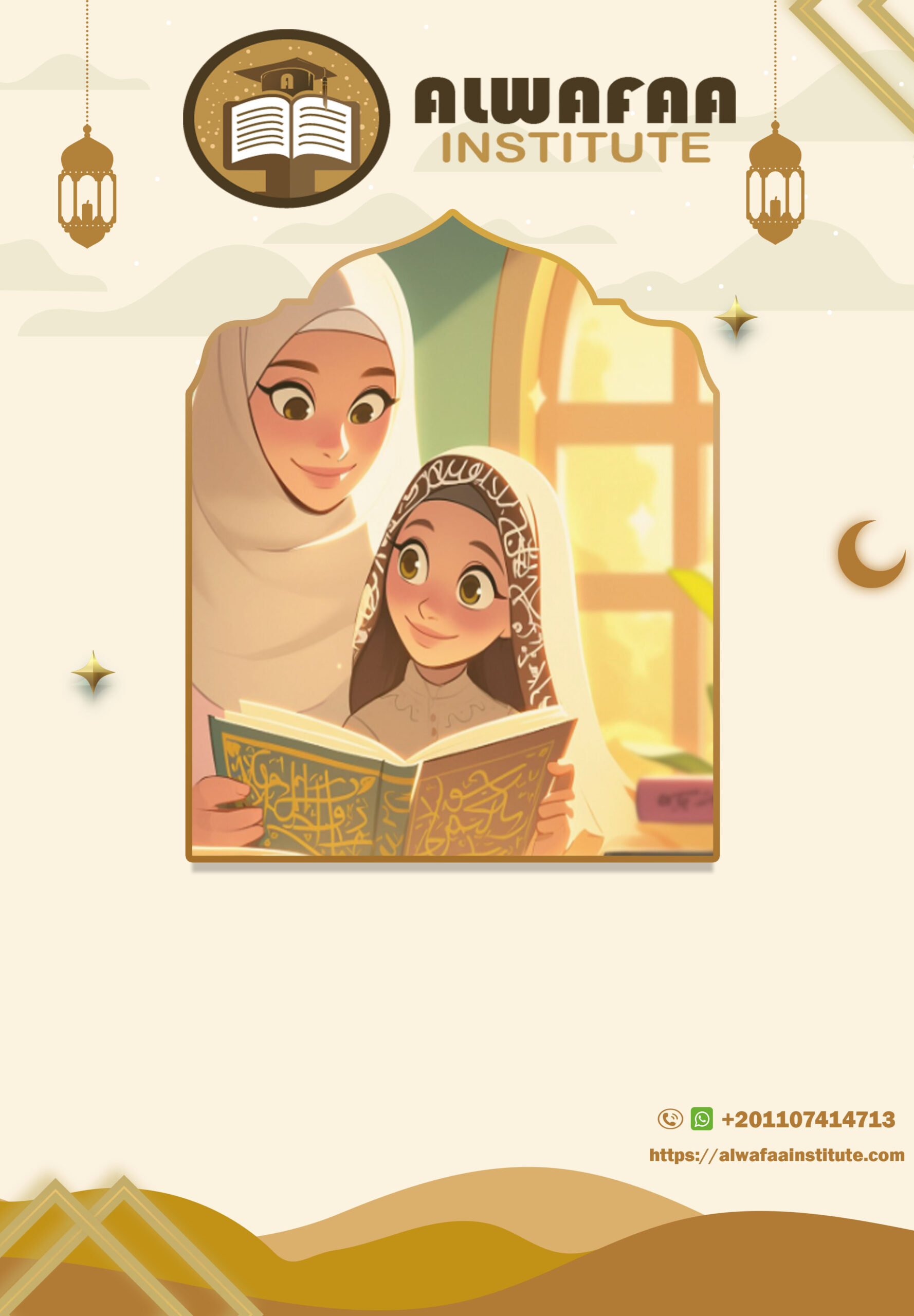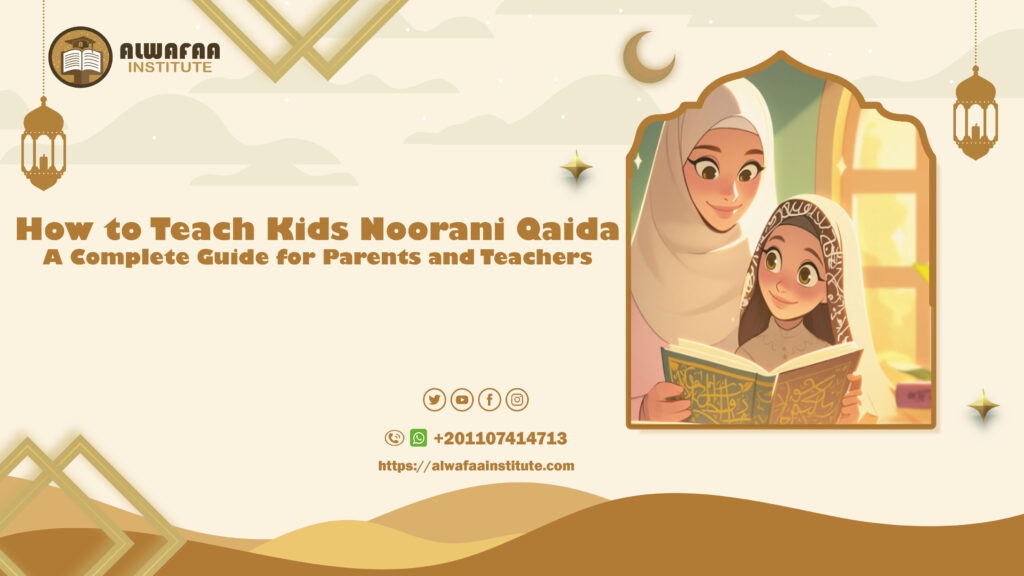How to Teach Kids Noorani Qaida: Teaching kids the Noorani Qaida is one of the most important first steps in introducing them to the Quran. For centuries, this foundational booklet has been used in Islamic education to teach children the basics of Arabic letters, pronunciation, Tajweed, and Quranic recitation. Parents, tutors, and online academies worldwide continue to rely on the Noorani Qaida for beginners because of its structured, simple, and effective approach.
In this article, we will explore everything you need to know about teaching kids Noorani Qaida, from its history and benefits to practical teaching methods, tips, and resources such as the Noorani Qaida PDF that you can easily download and use at home.
What is the Noorani Qaida?
The Noorani Qaida is a small educational booklet designed to teach children (and even adults) the correct way to read Arabic letters and words. It is the first step before moving on to the Holy Quran. The Qaida is divided into short, progressive lessons that cover:
-
Arabic letters (Alif, Ba, Ta, etc.)
-
Pronunciation rules (Makharij)
-
Short and long vowels (Harakat and Madd)
-
Sukoon, Shaddah, and Tanween
-
Joining letters to form words
-
Simple Quranic verses for practice
The structure of the Qaida ensures that learners develop a solid foundation in reading Arabic correctly with Tajweed rules.
Why Kids Should Start With Noorani Qaida
1. Builds Strong Quran Reading Skills
Children who start with Noorani Qaida for beginners develop a natural ability to recognize Arabic sounds, making their Quran reading journey smoother.
2. Teaches Correct Pronunciation (Tajweed)
The Qaida emphasizes proper pronunciation from the very beginning, preventing children from developing bad reading habits that are hard to correct later.
3. Easy to Understand for Kids
The lessons are short, repetitive, and progressive—perfect for young learners with limited attention spans.
4. Accessible and Widely Available
Parents and teachers can find Noorani Qaida PDFs online, making it easy to access, print, or study digitally.
Steps to Teach Kids Noorani Qaida
Teaching kids requires patience, consistency, and fun methods that keep them engaged. Here’s a step-by-step guide:
Step 1: Start with the Arabic Alphabet
Introduce each letter individually. Show your child the shape of the letter and pronounce it slowly. Encourage them to repeat after you. Visual aids like flashcards or digital apps can be useful.
Tip: Focus on proper pronunciation (Makharij). For example, teach the difference between “ح” and “هـ” or “س” and “ص.”
Step 2: Practice Short Vowels (Harakat)
Once your child recognizes letters, move to short vowels (fatha, kasra, damma). For example:
-
بَ = Ba
-
بِ = Bi
-
بُ = Bu
Repetition is key here.
Step 3: Introduce Long Vowels (Madd)
Teach the elongation rules with alif, waw, and ya. For example:
-
بَا (Baa)
-
بُو (Boo)
-
بِي (Bee)
This helps kids understand how vowel length changes meaning and sound.
Step 4: Teach Sukoon, Shaddah, and Tanween
Gradually introduce more complex rules such as Sukoon (resting letters), Shaddah (double letters), and Tanween (double vowels). These concepts prepare kids for actual Quranic words.
Step 5: Join Letters to Form Words
Help kids practice connecting letters to read short words, such as:
-
كَتَبَ (kataba)
-
دَرَسَ (darasa)
This transition is essential for moving from isolated letters to real Quranic verses.
Step 6: Practice with Short Quranic Verses
The final lessons in Noorani Qaida often include small Quranic phrases. Encourage your child to practice reciting them slowly and correctly.
Tips for Parents and Teachers
1. Keep Lessons Short
Kids learn best in 15–20 minute sessions. Avoid long lessons that cause fatigue.
2. Use Repetition and Rewards
Children need repetition to retain new sounds and rules. Use small rewards like praise or stickers to keep them motivated.
3. Make Learning Interactive
Incorporate digital resources like Noorani Qaida apps, audio recordings, or animated lessons. Pairing the Noorani Qaida PDF with audio recitations can help kids mimic correct sounds.
4. Practice Daily
Consistency is more important than duration. Even 10 minutes daily is better than an hour once a week.
5. Focus on Tajweed Early
Do not rush. Ensure your child is mastering each stage with correct Tajweed before moving on.
Teaching Noorani Qaida Online
With technology, many parents now prefer online classes. Online Quran academies often provide:
-
Qualified male and female tutors
-
One-on-one personalized lessons
-
Access to Noorani Qaida PDFs and practice materials
-
Audio-visual aids for better understanding
If your child is shy or prefers female guidance, you can find a female Quran tutor who specializes in teaching kids.
Benefits of Using Noorani Qaida PDF
-
Portable and Accessible: Parents can keep it on their phone or tablet.
-
Printable: You can print pages for offline practice.
-
Interactive: Many Noorani Qaida PDFs come with clickable audio links.
-
Free Resources: Many Islamic websites offer free Noorani Qaida PDFs for beginners.
Common Challenges and How to Overcome Them
Challenge 1: Child Gets Bored Quickly
Solution: Use games, flashcards, or online Noorani Qaida apps.
Challenge 2: Pronunciation Mistakes
Solution: Play audio recitations and ask your child to repeat after them.
Challenge 3: Irregular Practice
Solution: Fix a daily routine. Even 10 minutes before bedtime can make a huge difference.
FAQs About Teaching Kids Noorani Qaida
Q1: What age should kids start learning Noorani Qaida?
Most children can start around 4–5 years old when they can recognize letters and sounds.
Q2: How long does it take to complete Noorani Qaida?
On average, 4–6 months with consistent daily practice.
Q3: Can adults also learn from Noorani Qaida?
Yes, Noorani Qaida for beginners is equally effective for adults who are new to Quranic Arabic.
Q4: Where can I download Noorani Qaida PDF?
Many Islamic education websites offer free downloads. You can also find mobile apps with Noorani Qaida PDFs included.
Learn more: Noorani Qaida Course
Teaching Noorani Qaida Step by Step: A Detailed Breakdown
Many parents wonder how exactly to start and progress through Noorani Qaida lessons. Below is a detailed roadmap to make the journey easy and structured.
Lesson 1: Recognizing Arabic Letters
-
Begin with the 29 Arabic letters.
-
Teach each letter separately, focusing on its shape and sound.
-
Use colorful charts or printable Noorani Qaida PDF pages to visually engage kids.
Lesson 2: Differentiating Sounds
Some Arabic letters sound very similar but are produced from different parts of the mouth and throat. For example:
-
س (Seen) vs ص (Saad)
-
ح (Haa) vs خ (Khaa)
Teaching kids the correct articulation early will help avoid mistakes later.
Lesson 3: Learning Harakat (Short Vowels)
Introduce the three short vowels:
-
Fatha ( َ ) – produces an “a” sound.
-
Kasra ( ِ ) – produces an “i” sound.
-
Damma ( ُ ) – produces a “u” sound.
Kids should practice combining letters with vowels, such as بَ, بِ, بُ.
Lesson 4: Madd (Long Vowels)
Show how vowels are extended with alif, waw, and ya. This step is usually fun for kids as they get to stretch sounds.
Lesson 5: Sukoon and Shaddah
These symbols are challenging for beginners, but they are critical.
-
Sukoon ( ْ ) means no vowel.
-
Shaddah ( ّ ) means doubling the letter.
Repetition with examples from the Noorani Qaida PDF ensures kids grasp these rules.
Lesson 6: Tanween
Introduce double vowels like ـً, ـٍ, and ـٌ. Kids often enjoy the rhythm created when reciting Tanween words.
Lesson 7: Joining Letters
This step transitions children from theory to practical reading. Show them how letters look when joined, such as:
-
كتب (kataba)
-
درس (darasa)
Lesson 8: Practice with Short Verses
The final stage introduces children to Quranic verses for real application of what they learned.
Using Technology to Teach Noorani Qaida
Modern parents and teachers can enhance traditional learning by using digital tools:
-
Apps: Many Noorani Qaida apps provide interactive lessons with audio.
-
Videos: YouTube has free tutorials for Noorani Qaida for beginners.
-
PDF Resources: Parents can download a Noorani Qaida PDF and use it alongside apps.
-
Audio Recitations: Listening to correct pronunciation repeatedly helps kids mimic it correctly.
Role of Parents in Teaching Noorani Qaida
Parents play a crucial role, even if a tutor is hired.
-
Set a Routine: Fix a daily schedule, even if it’s just 15 minutes.
-
Encourage Consistency: Children should never go many days without practice.
-
Model Learning: If parents also revise Noorani Qaida, kids feel motivated.
-
Reward Efforts: Positive reinforcement works wonders with young learners.
Read More: Quran Recitation with Tajweed: Your Complete Guide to Mastering the Art of Reciting the Quran
Role of Tutors in Noorani Qaida Learning
A qualified tutor ensures proper Tajweed and structured progress. When selecting a teacher:
-
Check their experience in teaching Noorani Qaida for beginners.
-
Ask if they use digital aids like PDFs and audios.
-
Ensure they teach at the child’s pace without rushing.
Many families prefer female Quran tutors for young kids, especially daughters.
Practical Tips to Keep Kids Engaged
-
Gamify Learning: Turn lessons into challenges, e.g., “Read 5 letters correctly to earn a star.”
-
Use Flashcards: Visual memory helps children retain letters faster.
-
Storytelling: Build small stories around letters, like “Alif is the tall friend who always stands straight.”
-
Pair Study with Siblings: Kids often learn faster in pairs or groups.

Importance of Tajweed in Noorani Qaida
Tajweed is the science of Quranic pronunciation. Noorani Qaida lays the groundwork for Tajweed rules. For example:
-
Correctly pronouncing خ from the throat.
-
Stretching Madd letters properly.
-
Recognizing when to stop or continue in recitation.
Without Tajweed, Quranic recitation may change meaning. Hence, mastering Tajweed through Noorani Qaida is essential.
Noorani Qaida for Beginners: Common Mistakes
-
Skipping Basics: Some parents rush their kids into Quran recitation without Noorani Qaida. This often leads to mistakes.
-
Overloading Kids: Forcing long lessons makes kids lose interest.
-
Neglecting Tajweed: Teaching letters without focusing on correct articulation weakens future Quran recitation.
-
Irregular Practice: Learning Noorani Qaida requires daily consistency.
Resources for Noorani Qaida
-
Printed Qaida: Available in most Islamic bookstores.
-
Noorani Qaida PDF: Downloadable and printable for home use.
-
Mobile Apps: Provide interactive and audio-based learning.
-
Online Academies: Offer live tutors for one-on-one lessons.
Advanced Tips for Faster Learning
-
Repetition with Audio: Kids should repeat after listening to a teacher or Qaida audio.
-
Daily Review: Start each lesson with a quick revision of the previous one.
-
Small Goals: Divide the Qaida into weekly targets.
-
Patience: Every child learns at their own pace.
Why Noorani Qaida PDF is a Must-Have
Many parents rely on Noorani Qaida PDFs because they:
-
Are portable and can be used on phones, tablets, or computers.
-
Can be printed multiple times for practice.
-
Are free and easily available online.
-
Often come with audio guides for correct recitation.
For beginners, combining a Noorani Qaida PDF with teacher guidance is the best way forward.
Long-Term Benefits of Teaching Kids Noorani Qaida
-
Confidence in Quran Reading: Kids can open the Quran and read independently.
-
Better Pronunciation: They naturally apply Tajweed.
-
Stronger Memory: Noorani Qaida improves both reading and memorization skills.
-
Spiritual Connection: Kids feel closer to the Quran and Islam from an early age.
Teaching kids Noorani Qaida is not just about literacy in Arabic—it’s about building their lifelong relationship with the Quran. Starting with Noorani Qaida for beginners, supported by resources like Noorani Qaida PDFs, makes the journey smooth, structured, and rewarding.
Whether you are a parent, teacher, or tutor, your patience and consistency will lay a foundation that benefits children throughout their lives. By making learning fun, interactive, and consistent, you are planting seeds of love for the Quran in young hearts.

